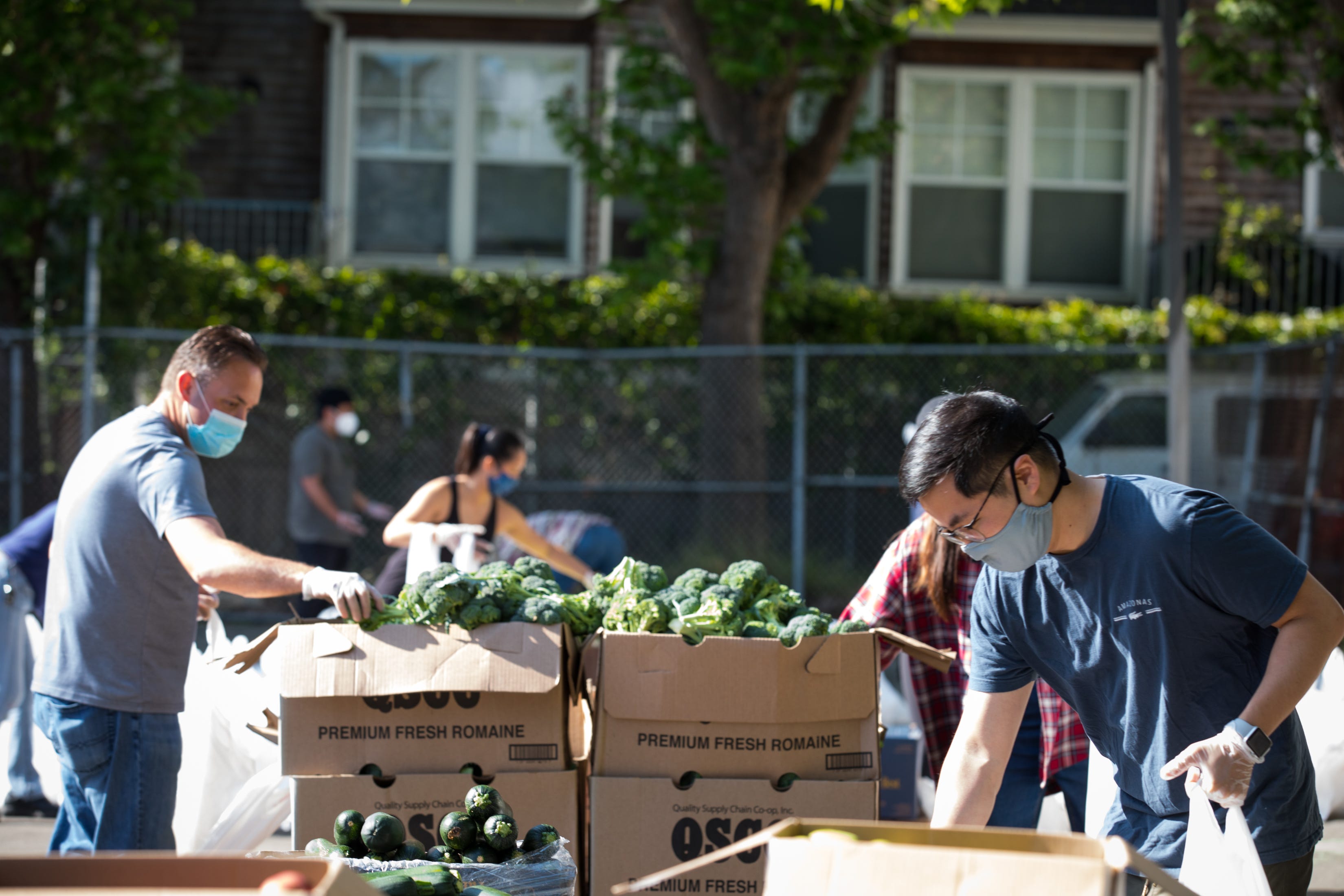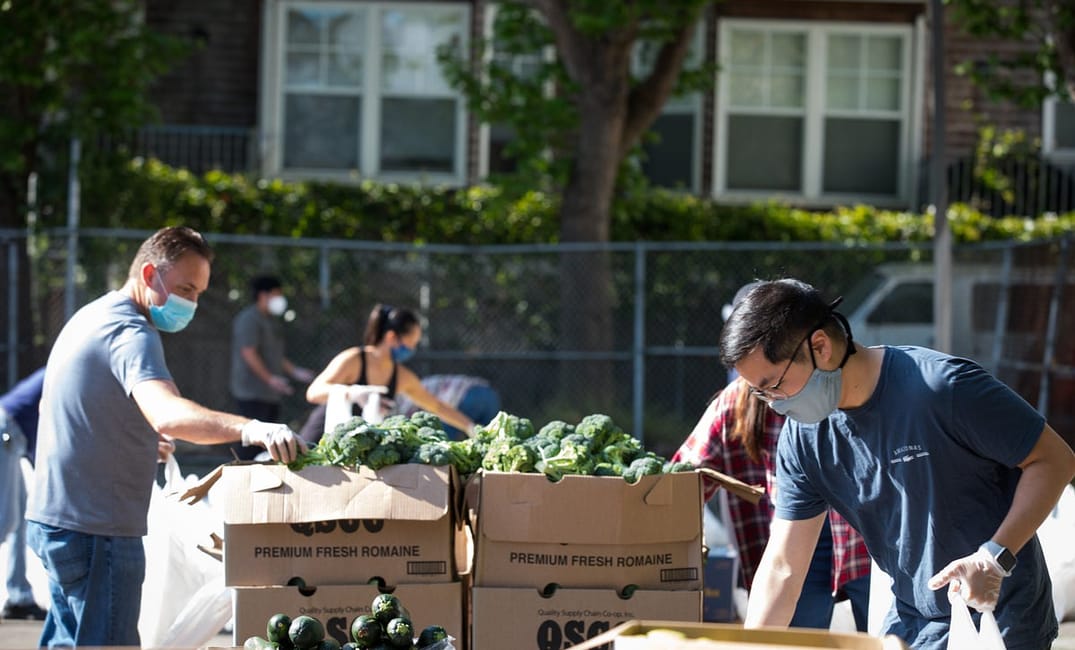
My last piece for The Bold Italic documented the anguish I was having processing the (still climbing) spike in anti-Asian violence, especially against our Asian American and Pacific Islander (AAPI) seniors. After much ruminating and nights of lost sleep, I decided that volunteering with the San Francisco-Marin Food Bank, which serves a large population of AAPI seniors, would be a good way to turn my worrisome and angry energies into a positive, non-violent action response to all the craziness.
It’s been a few months, with near-steady weekly shifts. I’ve worked at five sites so far, mostly at pop-up pantry locations at public schools in the city. The school closures made perfect venues for the food bank. Huge yards and parking lots provided enough room outdoors for delivery trucks, dozens of pallets of groceries, and space to socially distance both volunteers and a record number of food bank participants.
Aside from the service aspect of each shift, I enjoy the fresh air, the chance to get in some steps (10,000 is a rarity in these times), and the choice to either zone out while putting together 18-to-23-pound food bags in an assembly line, or engage with fellow volunteers from a distance.
We knew the pop-ups couldn’t remain at the schools forever.
Speaking of volunteers, the Bay Area—heavily populated with bleeding heart, overachieving do-gooders—produces the perfect one. Nearly everyone is early and proactive. Admittedly, that combination can yield behavior that’s not much in the spirit of service. There’s sometimes competitiveness amongst volunteers, like who can go down the line and fill grocery bags the quickest, impatiently waiting for six feet behind the slowpoke holding up the line because grabbing four handfuls of tangerines takes longer than the other stations.
(Actually, I’m mostly describing myself and just a few others. I’m guilty of this rude behavior and try to check myself, though my years working in the service industry means I’m used to performing repetitive, manual labor with speed. I am a beast. Or maybe I just think I am. Either way, I need to be a beast with patience and remember that we’re all there for the same good purpose.)
When I step outside of my self-perceived beast mode, though, I quickly glance at the line outside of the school property, which never seems to get shorter. Some food bank participants show up two hours before the pantries open for distribution, not wanting to be hungry for the next week.
There are currently 29 SFM Food Bank pop-up pantries, and the food bank is keeping in communication with participants on shifting locations, trying to give two weeks’ advance notice about changes.
At every site I’ve worked thus far, I see time and again that the participants are overwhelmingly AAPI seniors. I know this, but seeing it makes me feel a twinge of sadness inside. I look at the bilingual distribution volunteers working the front of the line, fluidly switching between Cantonese and English. As I throw a giant turnip into my bag and grab some celery, I am envious of those volunteers and embarrassed that I don’t know enough Cantonese to fill that role, which the food bank always desperately needs. Still, I tell myself that I am serving Asian seniors like I wanted, just from a greater distance.
Having settled into this new routine, I was surprised to receive an email a few weeks ago. ”Thank you for signing up to volunteer at Abraham Lincoln High School this Friday. Unfortunately, this week’s shift has been canceled,” it read.
That food bank location, with less than a week’s notice, had to quickly pivot to distributing disaster boxes outside of school grounds, but could only have staff work due to pandemic safety protocols. I hopped on to another shift for that day at A.P. Giannini, seeing some of the volunteers from the Lincoln site had done the same. Shortly afterward, the volunteer sign-up section of the food bank website stated that my newly chosen volunteer site was going to cease operations this month in June.
We knew the pop-ups couldn’t remain at the schools forever.
And of course, the news of schools reopening was a relief for some parents and students. While the economy has been slowly reopening as vaccine rollouts reach more communities, unemployment has also been shrinking, though the reasons may not be so great. That’s partially why hunger isn’t disappearing from the Bay proportional to the rate of the rest of society reopening. During Covid-19, SFM Food Bank participants jumped from 32,000 households per week to 62,000 last summer. While the need “leveled at 55,000 households per week during the last several months, we’re not seeing any kind of decline at all,” said Keely Hopkins, SFM Food Bank Communications and Social Media Manager.
While the food bank is no stranger to shifting operations, having served the city and North Bay for more than 35 years, this major change amidst a crisis presents an added layer of urgency to our city’s hunger problem. There are currently 29 SFM Food Bank pop-up pantries, and the food bank is keeping in communication with participants on shifting locations, trying to give two weeks’ advance notice about changes. It’s not only schools reopening that is affecting many of the pantries, though, “it’s across public spaces,” Hopkins shared. “Schools were the first ones to move. Right now we have the street closures, and we’re going to lose those locations as traffic returns. Our poor pop-up pantry team has been in full scramble mode the last couple of months,” she continued.
Not to fear, though. Some new locations are next to or very near the school pantries, and some neighborhood pantries with whom the food bank partnered pre-pandemic have been reopening. Logistics are being smoothed out as you read this, and no pantries will actually disappear. Eventually, the food bank hopes to return to the farmers market-style of food distribution, instead of the current distribution model. Participants can choose what they want instead of being handed a blind box full of pre-packaged groceries, which may contain foods not commonly eaten in some cultures, like peanut butter or boxed macaroni and cheese that are more common in the mainstream white American diet.
Sign up for The Bold Italic newsletter to get the best of the Bay Area in your inbox every week.
As for the do-gooder volunteers, perhaps like myself, Hopkins emphasizes, “We’re still here, we still need volunteers…we’re still outside and are social distancing.” Volunteers are needed more on the weekdays than the weekends, especially on Mondays and Thursdays.
For those in need of food and not sure where to go amidst this city-wide operations shift, visit the online food locator or call the number on the food locator page.







